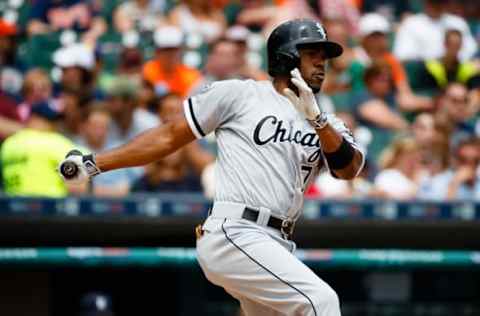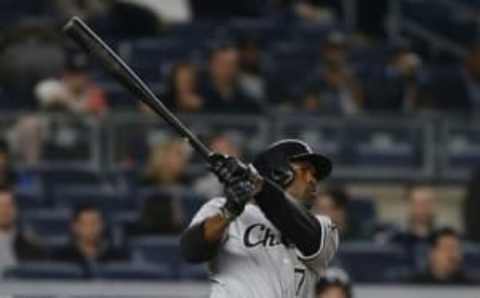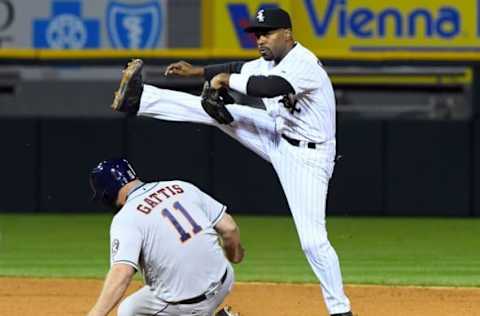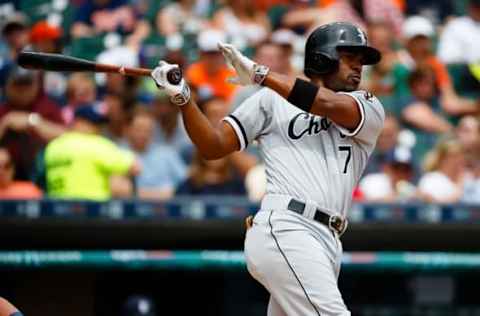San Francisco Giants: What Can We Expect from Jimmy Rollins?


The San Francisco Giants have signed shortstop Jimmy Rollins to a minor league deal. What type of performance can we expect?
Just yesterday, the San Francisco Giants signed shortstop Jimmy Rollins to a minor league deal. As our own Matt Veasey wrote yesterday, the contract will allow him to compete for a backup role in the major leagues during spring training as a non-roster player. If he makes the team out of spring training, he will earn $1 million over the course of the season.
Whether or not Rollins can earn a job with San Francisco Giants is a serious question. He will have to beat out Kelby Tomlinson and Ehire Adrianza in order to start the season in San Francisco. Achieving this would be no small feat considering the age gap between the players. Tomlinson and Adrianza are 26 and 27 years old, respectively. Rollins, on the other hand, just turned 38 last month.
Tomlinson and Adrianza may not necessarily be top prospects, and they are probably not future superstars. Nevertheless, encountering a backup-level performance by relatively young players would be less surprising than finding such a showing from a 17-year veteran whom the Chicago White Sox released. Yes, Rollins’ output last season was so poor that even the Chicago White Sox wanted to go another way.
Once spring training begins, the San Francisco Giants will have to determine whether or not Rollins brings enough value to the table to justify demoting either of the two current backups. Given that Tomlinson and Adrianza have been semi-productive players over the past few years, this is probably unlikely. Tomlinson has been the better player of the two, but he is not exactly a proven option at shortstop.
Further complicating the matter, Adrianza is a switch-hitter and more experienced in general. If Rollins were to somehow show in spring training that he is a better batter and shortstop than Adrianza, then it is entirely possible that the San Francisco Giants go with a Rollins-Tomlinson tandem for backups. Rollins is also a switch-hitter, so losing that aspect of Adrianza would be less damaging.
Now that we have established a way for Rollins to make the big leagues, let’s examine what we can expect from him next year. For the sake of discussion, let’s also assume that he wins the spring training battle against Adrianza and focus on predicting regular season results. While this victory for Rollins is far from given, the tiny sample size of spring training means that predicting statistics in that window has less to do with skill and more with luck (more on this here at The Economist from 2015). Odds are that the San Francisco Giants recognize this and will instead focus on scouting reports and fundamentals, rendering numerical predictions useless.
To get an idea of what production we can expect from Jimmy Rollins, let’s look at what he has done for the past few seasons. Since the start of 2014, Jimmy Rollins has appeared in 323 games. Over that time, he experienced a sizable decrease in production.

His 2014 season, then with the Philadelphia Phillies, was quite good. Despite a .243 batting average, he slugged 17 home runs and swiped 28 bags. He also walked more than 10 percent of the time and displayed above-average defense. FanGraphs rated his season at 3.9 wins above replacement – a lofty figure for any shortstop, especially one who was 35 years old at the time.
The success prompted the rebuilding Phillies to search for a potential trading partner, and they found one in the Los Angeles Dodgers. That season saw him bat a career-worst .224, although he did manage to hit for decent power. His defense and base running decayed, and he eventually lost his starting job to Corey Seager in September. In just about a year, he went from being an All-Star caliber player to roughly replacement level.
Things only got worse last year with the Chicago White Sox. He only survived 41 games before the Sox axed him, and his offensive statistics went from bad to terrible. Not only did the outcomes worsen, but his contact rates continued their slide from elite to average. Rollins also started swinging at more pitches outside the strike zone. With leadership as his only real asset, it did not make much sense for the White Sox to allow him to capture any more at-bats.
Continue reading for more concrete predictions for Jimmy Rollins…

So, at this point in his career, what would Jimmy Rollins bring to the San Francisco Giants?
Steamer, a popular projection algorithm, forecasts a .229/.301/.350 batting line. Any predictions of raw statistics, however, are meaningless since it does not foresee the 37-year-old receiving any playing time. This is probably a combination of his release from the White Sox and age than any spring training battle prediction.
Even if Steamer has very little raw data, we can still adjust its sentiment for the batting statistics featuring averages. Steamer’s equations will give us a fairly good baseline with which to work, and we can then use our intuition to improve upon these figures. As for the non-offense statistics, let’s focus on instead grading these areas with adjectives instead of numbers. Estimating raw figures for a part time player would be quite challenging given the fluid nature of the job.
Let’s begin with base running. As noted above, Rollins’ abilities on the base paths have declined notably over the past three seasons. Still, he has fairly decent speed, meaning that there is still some sort of potential value there. Even in the depths of last season, his base running was average. Counting in an extra year of aging on his knees probably means that a large improvement is unlikely, but he has generally maintained value in this area despite his age. It would not be unrealistic for the San Francisco Giants to expect average base running from Jimmy Rollins next year.
As for defense, the days of him being a Gold Glove-caliber defender are almost certainly gone. His glove work has been okay, but not great recently. Ultimate Zone Rating and Defensive Runs Saved have rated his work as slightly worse than average in the past five years or so, and this trend is likely to continue into the future. Expecting slightly below average defense, albeit at a demanding position, is probably a safe bet.
Continue on to find predictions for Jimmy Rollins’ offense…

What kind of production might Jimmy Rollins provide the San Francisco Giants at the plate?
Now, we finally come to the offensive statistics. The aforementioned declining contact rates and worsening plate discipline does not bode well for a comeback next year. Interestingly enough, his percentage of hard-hit balls dropped last season, and his exit velocity was subpar. Unfortunately, the exit velocity data for prior seasons is not available.
Some more optimistic fans may point to Rollins’ low batting average on balls in play as a source for further improvement. This, however, is unlikely since he pulls nearly half of his batted balls and quite a few of those are hit on the ground. Expect Rollins to post another BABIP in the .250 to .270 range.
More from Call to the Pen
- Philadelphia Phillies, ready for a stretch run, bomb St. Louis Cardinals
- Philadelphia Phillies: The 4 players on the franchise’s Mount Rushmore
- Boston Red Sox fans should be upset over Mookie Betts’ comment
- Analyzing the Boston Red Sox trade for Dave Henderson and Spike Owen
- 2023 MLB postseason likely to have a strange look without Yankees, Red Sox, Cardinals
A more likely argument that Rollins could improve next year is that he had a relatively small sample size of 41 games last season. This means that the 166 plate appearances he received are not a large enough amount to draw accurate conclusions from his traditional batting statistics. One could make the case that he will improve a bit and that the dip in exit velocity and contact rates are due to randomness in the sample.
As lovely as it would be for the shortstop to improve next season, an extra year of aging will do him no favors. If his contact rates improve a bit, which is uncertain given that they have been on the decline for five years, then perhaps his batting average has room to grow. Still, optimism has led to many lapses in judgement when it comes to evaluating baseball players. A batting average in the range of .220 to .230 and an on-base percentage between .290 and .300 would be a decent bet.
Unfortunately, neither of those ranges are that great. Any hopes of regaining some value with added power are probably unjustified given that the San Francisco Giants play in a park that favors pitchers. Still, he will probably retain some pop and post an isolated power around .120. That would give a range of slugging percentages between .340 and .350. This would leave his offense at markedly below average.
Next: Giants Sign Jimmy Rollins
Even if Jimmy Rollins provides relatively no value to the San Francisco Giants with his bat, having average base running, slightly below average defense, and exceptional leadership could justify his status as a backup infielder. Ehire Adrianza would probably provide the Giants with better defense and offense, but whether this outweighs any potential chemistry or leadership boost that Rollins would bring is up to the San Francisco Giants to decide.